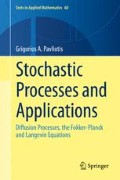Abstract
In this chapter, we study some of the basic properties of Markov stochastic processes, and in particular, the properties of diffusion processes. In Sect. 2.1, we present various examples of Markov processes in discrete and continuous time. In Sect. 2.2, we give the precise definition of a Markov process and we derive the fundamental equation in the theory of Markov processes, the Chapman–Kolmogorov equation. In Sect. 2.3, we introduce the concept of the generator of a Markov process. In Sect. 2.4, we study ergodic Markov processes. In Sect. 2.5, we introduce diffusion processes, and we derive the forward and backward Kolmogorov equations. Discussion and bibliographical remarks are presented in Sect. 2.6, and exercises can be found in Sect. 2.7.
Access this chapter
Tax calculation will be finalised at checkout
Purchases are for personal use only
Notes
- 1.
In later chapters, we will also consider Markov processes with state space a subset of \(\mathbb{R}^{d}\), for example the unit torus.
- 2.
In fact, all we need is that \(u \in C^{2,1}(\mathbb{R} \times \mathbb{R}_{+})\). This can be proved using our assumptions on the transition function, on f, and on the drift and diffusion coefficients.
- 3.
The backward Kolmogorov equation can also be derived using Itô’s formula. See Chap. 3.
- 4.
References
A. Einstein. Investigations on the theory of the Brownian movement. Dover Publications Inc., New York, 1956. Edited with notes by R. Fürth, Translated by A. D. Cowper.
S. N. Ethier and T. G. Kurtz. Markov processes. Wiley Series in Probability and Mathematical Statistics: Probability and Mathematical Statistics. John Wiley & Sons Inc., New York, 1986.
L. C. Evans. Partial Differential Equations. AMS, Providence, Rhode Island, 1998.
C. W. Gardiner. Handbook of stochastic methods. Springer-Verlag, Berlin, second edition, 1985. For physics, chemistry and the natural sciences.
I. I. Gikhman and A. V. Skorokhod. Introduction to the theory of random processes. Dover Publications Inc., Mineola, NY, 1996.
A. Guionnet and B. Zegarlinski. Lectures on logarithmic Sobolev inequalities. In Séminaire de Probabilités, XXXVI, volume 1801 of Lecture Notes in Math., pages 1–134. Springer, Berlin, 2003.
W. Horsthemke and R. Lefever. Noise-induced transitions, volume 15 of Springer Series in Synergetics. Springer-Verlag, Berlin, 1984. Theory and applications in physics, chemistry, and biology.
A. Lasota and M. C. Mackey. Chaos, fractals, and noise, volume 97 of Applied Mathematical Sciences. Springer-Verlag, New York, second edition, 1994.
L. Lorenzi and M. Bertoldi. Analytical Methods for Markov Semigroups. CRC Press, New York, 2006.
E. Nelson. Dynamical theories of Brownian motion. Princeton University Press, Princeton, N.J., 1967.
J. R. Norris. Markov chains. Cambridge Series in Statistical and Probabilistic Mathematics. Cambridge University Press, Cambridge, 1998.
G. A. Pavliotis and A. M. Stuart. Multiscale methods, volume 53 of Texts in Applied Mathematics. Springer, New York, 2008. Averaging and homogenization.
R. F. Pawula. Approximation of the linear Boltzmann equation by the Fokker–Planck equation. Phys. Rev, 162(1):186–188, 1967.
M. Reed and B. Simon. Methods of modern mathematical physics. I. Academic Press Inc., New York, second edition, 1980. Functional analysis.
D. Revuz and M. Yor. Continuous martingales and Brownian motion, volume 293 of Grundlehren der Mathematischen Wissenschaften [Fundamental Principles of Mathematical Sciences]. Springer-Verlag, Berlin, third edition, 1999.
D. W. Stroock. Partial differential equations for probabilists, volume 112 of Cambridge Studies in Advanced Mathematics. Cambridge University Press, Cambridge, 2008.
D. W. Stroock. An introduction to Markov processes, volume 230 of Graduate Texts in Mathematics. Springer-Verlag, Berlin, 2005.
G. Teschl. Mathematical methods in quantum mechanics, volume 99 of Graduate Studies in Mathematics. American Mathematical Society, Providence, RI, 2009. With applications to Schrödinger operators.
N. Wax (editor). Selected Papers on Noise and Stochastic Processes. Dover, New York, 1954.
Author information
Authors and Affiliations
Rights and permissions
Copyright information
© 2014 Springer Science+Business Media New York
About this chapter
Cite this chapter
Pavliotis, G.A. (2014). Diffusion Processes. In: Stochastic Processes and Applications. Texts in Applied Mathematics, vol 60. Springer, New York, NY. https://doi.org/10.1007/978-1-4939-1323-7_2
Download citation
DOI: https://doi.org/10.1007/978-1-4939-1323-7_2
Published:
Publisher Name: Springer, New York, NY
Print ISBN: 978-1-4939-1322-0
Online ISBN: 978-1-4939-1323-7
eBook Packages: Mathematics and StatisticsMathematics and Statistics (R0)

